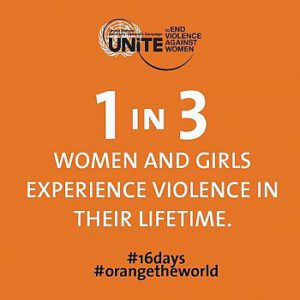The 25th of November is the International Day for the Elimination of Violence Against Women. Historically the date marks the day on which the Dominican dictator Rafael Trujillo ordered three political activists – the Mirabal sisters – to be assassinated for openly fighting his regime. Since 1999 the United Nations has on this day especially drawn attention to the violence women and girls experience all over the world. This year’s theme of the UN-led campaign is “Together We Can End Gender-Based Violence in Education!”, and since the 10th of December is the International Human Rights Day, the 16 days in between are devoted to actions calling for elimination of all forms of gender-based violence (GBV).
The aim of these 16 days of activism is to achieve higher visibility of GBV as a violation of human rights, and not just a “problem for women”, or “women’s issue”. Every year an activist toolkit is published to help planning of local campaigns and introduce the issue, and this year the toolkit includes suggestions for advocacy focused on institutional, legal, and policy change, i.e. for effective laws, policies and institutions that effectively prevent and address GBV in education that tie GBV and human rights frameworks.
 Gender-based violence refers to violence that targets people or groups on the basis of their gender, and although men, women, boys and girls can be exposed to GBV, the overwhelming majority affected by GBV are women, and therefore the terms GBV and violence against women are often used interchangeably. According to a WHO report from 2013 the global prevalence of physical and/or sexual intimate partner violence among all ever-partnered women was 30.0%. The prevalence was highest in the WHO African, Eastern Mediterranean and South-East Asia Regions, where approximately 37% of ever-partnered women reported having experienced physical and/or sexual intimate partner violence at some point in their lives. Furthermore, the study carried out by the European Agency for Fundamental rights in 2014 found that in the European Union 33% of women have been exposed to physical and/or sexual violence by partner or non-partner since the age of 15. GBV exists everywhere in the world and is in no way only a problem of developing societies, the “Global South” or low-income countries, as biased thought patterns would lead people to assume.
Gender-based violence refers to violence that targets people or groups on the basis of their gender, and although men, women, boys and girls can be exposed to GBV, the overwhelming majority affected by GBV are women, and therefore the terms GBV and violence against women are often used interchangeably. According to a WHO report from 2013 the global prevalence of physical and/or sexual intimate partner violence among all ever-partnered women was 30.0%. The prevalence was highest in the WHO African, Eastern Mediterranean and South-East Asia Regions, where approximately 37% of ever-partnered women reported having experienced physical and/or sexual intimate partner violence at some point in their lives. Furthermore, the study carried out by the European Agency for Fundamental rights in 2014 found that in the European Union 33% of women have been exposed to physical and/or sexual violence by partner or non-partner since the age of 15. GBV exists everywhere in the world and is in no way only a problem of developing societies, the “Global South” or low-income countries, as biased thought patterns would lead people to assume.
Hedda blog 1The data concerning the prevalence of GBV specifically in education and in schools, however, is unfortunately very limited compared to the more general data cited above, and thus the full scale of the problem is unknown. Much research about violence against children has neglected the aspect of gender, although most forms of school violence are also deeply rooted in gender inequalities and norms. The studies that are available show the large extent of GBV in schools. A study in the Netherlands found that 27% of students had been sexually harassed by school personnel (Mncube and Harber, 2013). In the United Kingdom, it is estimated that one in three 16–18 year olds have experienced unwanted sexual touching in schools (EWAN, 2015). This violence that is taking place in schools is not isolated from wider society, it reflects the underlying gender norms and stereotypes, and acceptability of violence.
GBV in the schools has a negative impact on the educational attainment and the quality of school life as it creates an unhealthy atmosphere, mistrust, feelings of not belonging, low self-esteem, anxiety and isolation, and increases absenteeism, academic failures and the number of dropouts. Violence against women is rooted in gender inequality and stereotypes. Gender norms and stereotypes are taught to children starting from their early childhood. Girls are taught to be silent, submissive and beautiful princesses and boys have to be tough, not cry. Children who see violent behaviour in their childhood learn that it is an acceptable way for solving conflicts. Violence in its nature is trans-generational, witnessing or experiencing it in the childhood increases the risk to become violent or become re-victimised in the adulthood. Witnessing family violence increases also the risk for children becoming violent toward their mother. Worldwide 176 million- one in four children under age five are living with a mother who is a victim of intimate partner violence.
attainment and the quality of school life as it creates an unhealthy atmosphere, mistrust, feelings of not belonging, low self-esteem, anxiety and isolation, and increases absenteeism, academic failures and the number of dropouts. Violence against women is rooted in gender inequality and stereotypes. Gender norms and stereotypes are taught to children starting from their early childhood. Girls are taught to be silent, submissive and beautiful princesses and boys have to be tough, not cry. Children who see violent behaviour in their childhood learn that it is an acceptable way for solving conflicts. Violence in its nature is trans-generational, witnessing or experiencing it in the childhood increases the risk to become violent or become re-victimised in the adulthood. Witnessing family violence increases also the risk for children becoming violent toward their mother. Worldwide 176 million- one in four children under age five are living with a mother who is a victim of intimate partner violence.
In my native country Estonia the quality of primary and secondary education is considered to be one of the best in Europe, everyone’s right to education is enshrined in the Constitution, and education is free. Estonian women are more educated than men, but at the same time at home children are exposed to stereotypical gender roles as the majority of unpaid care work is still done by women. Furthermore, the gender pay gap in Estonia is one of the biggest in the European Union reaching almost 30%, but some politicians publicly justify this injustice and claim that the reason behind this is “just biological” and “why do women not ask for more money then”. I wonder how can we expect that girls who are taught to be quiet and submissive in the childhood to suddenly change when they grow up and take on leading roles? How can we expect that they will suddenly feel comfortable stepping up against harassment and violence? The more I have learned about the consequences and roots of GBV, the more I have begun to understand the importance of what we teach children – and not only that we teach them foreign languages and mathematics, but what we teach about what they can do and who they can become. GBV is a social justice issue, and a question of power relations. It is valuable to have such global campaigns to make GBV more visible as I believe that a lot of people, including parents and teachers, need to be educated about the ways gender stereotypes can really hurt children and lead to GBV. Thus, this campaign should be seen as an opportunity to speak and write about GBV, so that it could become more and more difficult to ignore.
By Hedda Lippus, PhD researcher, University of Tartu/Emory University
This post originally appeared on the Centre for Cultures of Reproduction, Technologies and Health blog, 04.12.17


Leave a Reply